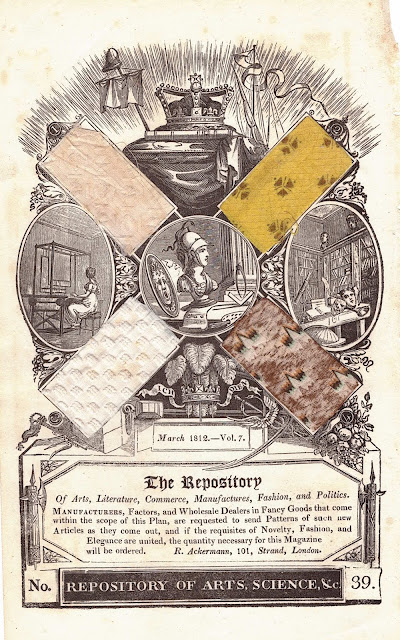Here’s
another post in our ongoing series on Regency fabrics.
As I have in previous posts, I’ll be examining actual fabric samples glued into several earlier editions of Ackermann’s Repository, samples supplied by the manufacturers and published by Ackermann in order to boost the British cloth-making industry at a time when exporting British goods to Europe was almost impossible because of the Napoleonic war. I'll give you a close-up scan of each sample, the published description if available, and my own observations of the color, weight, condition, and similarity to present-day materials, to give you as close a picture as possible of what these fabrics are like.
Today’s four samples are from the March 1812 issue of Ackermann’s Repository. The overall condition of my copy is very good: the page has been trimmed a little close on the outside, but the paper itself is not toned and has minimal spotting. All four fabric samples are present and in good condition, if a little creased in places.
Here
we go!
No. 1. A figured Cisalpine washing silk, for evening wear; and is to be pur-chased of every colour and shade. This light article is adapted to the various seasons of the year, according to the trimmings with which it is ornamented. In winter the tunics and robes were consistently trimmed with fur or swansdown; in the more genial seasons, lace must be considered most appropriate; and in the ball or full dress, white beads or bugles have a very pretty effect. It is manufactured and sold by D. and R. Hodges, silk-manufacturers, No. 12, Henrietta-street, Covent-garden.
My comments: I love this one! It didn’t photograph very well, alas, but it’s a light ecru colored silk patterned with bars and bisected circles that remind me of coffee beans woven in, with the pattern being much more reflective than the background. It’s a very light, thin fabric, smooth and air, but I would be concerned about its fragility: fine for an evening or dinner dress, but I don’t think I’d want to dance in it!
No. 2. A printed checked cambric muslin, calculated for the more quiet order of decora-tion. There is no trimming that can give any advan-tage to this article, which should be formed in plain wraps, or high round robes, with long sleeves and frills of lace, or collars and cuffs of needle-work. To be purchased of T. and J. Smith, 4, Tavistock-street, Covent-garden.
My comments: I wouldn’t call this checked (which makes me think of gingham) as the grid pattern is woven into the fabric, with the brown pattern a bit sloppily printed on (easier to see in real life than in this scan.) I think it would be more attractive without the print. It has a nice soft, supple hand and a soft sheen that again is not coming through in the scan, but again, not very sturdy.
No. 3. Is a pretty description of muslin adapted for morning wraps, spring pelisses, and children’s wear. This article we obtained from the house of Millard in the city, whose celebrity has often been a subject of discussion in our Repository, as well as of general notoriety with our fair fashionables at the west end of the town. Articles of every choice description, and of the greatest novelty, are dispersed to the various houses in town, and the various watering-places, from this extensive ware-house, so long renowned for the immediate sale of the Honourable East India Company’s goods; and we learn that the goods vended from their recent sale are of a superior description, and, from the deficiency of foreign trade, extremely cheap. Families purchasing pieces or half-pieces, are supplied by this house on the same terms as the trade.
My comments: Curiously, the scan of this is backward to what this looks like in real life: the woven-in square pattern (made of tiny loops of thread of a thicker, fluffier cotton thread) stands out from the background. Yes, a nice fabric for little dresses or boy’s skeleton suits…and now I feel that I have to go and research the vendor, Millard, because it sounds like there’s a lot of interesting history there…
No.4 exhibits a very striking and appropriate printed Marseilles for gentlemen’s waistcoats. There is scarcely any coat with which this animated article can ill accord, which accounts for its being so much called for by men of rank and fashion, who find it also so appropriate an article for the demi-saisons. It is sold by Messrs. Maund and Co., mercers and woollen-drapers, Cornhill.
My comments: It has always puzzled me why the fabrics considered suitable for men’s waistcoats of the time are always very thick and sturdy, when the fabrics for dresses are so light and often flimsy…but back to the matter at hand. This is a fairly heavy-duty wool woven in a diamond pattern and then overprinted with a design in orange, brown, and mint green that again reminds me of 1930s quilting cottons or feed sacks
What do you think of this month’s fabrics?










No comments:
Post a Comment